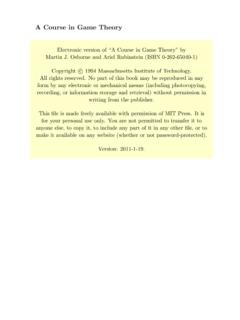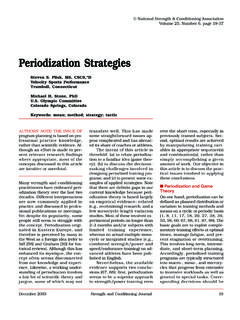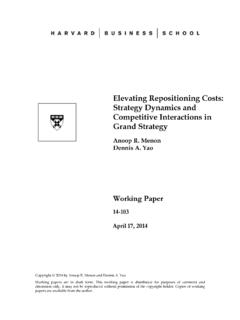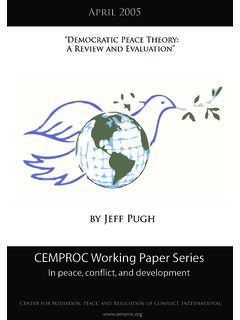Transcription of Managerial Economics - majalil
1 ManagerialEconomicsTheory and PracticeThis Page Intentionally Left Blank ManagerialEconomicsTheory and PracticeThomas J. WebsterLubin School of BusinessPace UniversityNew York, NYAmsterdam Boston Heidelberg London New York Oxford ParisSan Diego San Francisco Singapore Sydney TokyoThis book is printed on acid-free 2003, Elsevier (USA).All Rights part of this publication may be reproduced or transmitted in any form or by anymeans, electronic or mechanical, including photocopy, recording, or any informationstorage and retrieval system, without permission in writing from the may be sought directly from Elsevier s Science & Technology RightsDepartment in Oxford, UK: phone: (+44) 1865 843830, fax: (+44) 1865 853333,e-mail: You may also complete your request on-linevia the Elsevier Science homepage ( ), by selecting CustomerSupport and then Obtaining Permissions.
2 Academic PressAn imprint of Elsevier Science525 B Street, Suite 1900, San Diego, California 92101-4495, Press84 Theobald s Road, London WC1X 8RR, of Congress Catalog Card Number: 2003102999 International Standard Book Number: 0-12-740852-5 PRINTED IN THE UNITED STATES OF AMERICA0304050607 7654321To my sons, Adam Thomas and Andrew NicholasThis Page Intentionally Left Blank Contents1 IntroductionWhat is Economics 1 Opportunity Cost 3 Macroeconomics Versus Microeconomics 3 What is Managerial Economics 4 Theories and Models 5 Descriptive Versus Prescriptive Managerial Economics 8 Quantitive Methods 8 Three Basic economic Questions 9 Characteristics of Pure Capitalism 11 The Role of Government in Market Economies 13 The Role of Profit 16 theory of the Firm 18 How Realistic is the Assumption of Profit Maximization? 21 Owner-Manager/Principle-Agent Problem 23 Manager-Worker/Principle-Agent Problem 25 Constraints on the Operations of the Firm 27 Accounting Profit Versus economic Profit 27 Normal Profit 30 Variations in Profits Across Industries and Firms 31 Chapter Review 33 Key Terms and Concepts 35 Chapter Questions 37viiChapter Exercises 39 Selected Readings 412 Introduction to Mathematical EconomicsFunctional Relationships and economic Models 44 Methods of Expressing economic and Business Relationships 45 The Slope of a Linear Function 47An Application of Linear Functions to Economics 48 Inverse Functions 50 Rules of Exponents 52 Graphs of Nonlinear Functions of One Independent Variable 53 Sum of a Geometric Progression 56 Sum of an Infinite Geometric Progression 58 economic Optimization 60 Derivative of a
3 Function 62 Rules of Differentiation 63 Implicit Differentiation 71 Total, Average, and Marginal Relationships 72 Profit Maximization: The First-order Condition 76 Profit Maximization: The Second-order Condition 78 Partial Derivatives and Multivariate Optimization: The First-orderCondition 81 Partial Derivatives and Multivariate Optimization: The Second-orderCondition 82 Constrained Optimization 84 Solution Methods to Constrained Optimization Problems 85 Integration 88 Chapter Review 92 Chapter Questions 94 Chapter Exercises 94 Selected Readings 973 The Essentials of Demand and SupplyThe Law of Demand 100 The Market Demand Curve 102viiiContentsOther Determinants of Market Demand 106 The Market Demand Equation 110 Market Demand Versus Firm Demand 112 The Law of Supply 113 Determinants of Market Supply 114 The Market Mechanism: The Interaction of Demand and Supply 118 Changes in Supply and Demand.
4 The Analysis of Price Determination 123 The Rationing Function of Prices 129 Price Ceilings 130 Price Floors 134 The Allocating Function of Prices 136 Chapter Review 137 Key Terms and Concepts 138 Chapter Questions 140 Chapter Exercises 142 Selected Readings 144 Appendix 3A 1454 Additional Topics in Demand TheoryPrice Elasticity of Demand 149 Price Elasticity of Demand: The Midpoint Formula 152 Price Elasticity of Demand: Weakness of the Midpoint Formula 155 Refinement of the Price Elasticity of Demand Formula: Point-priceElasticity of Demand 157 Relationship Between Arc-price and Point-price Elasticities of Demand 160 Price Elasticity of Demand: Some Definitions 160 Point-price Elasticity Versus Arc-price Elasticity 162 Individual and Market Price Elasticities of Demand 164 Determinants of the Price Elasticity of Demand 165 Price Elasticity of Demand, Total Revenue, and Marginal Revenue 168 Formal Relationship Between the Price Elasticity of Demand and Total Revenue 174 Using Elasticities in Managerial Decision Making 181 Chapter Review 186 Key Terms and Concepts 188 Chapter Questions 190 ContentsixChapter Exercises 191 Selected Readings 1945 ProductionThe Role of the Firm 195 The Production Function 197 Short-run Production Function 201 Key Relationships.
5 Total, Average, and Marginal Products 202 The Law of Diminishing Marginal Product 205 The Output Elasticity of a Variable Input 207 Relationships Among the Product Functions 208 The Three Stages of Production 211 Isoquants 212 Long-run Production Function 218 Estimating Production Functions 222 Chapter Review 225 Key Terms and Concepts 226 Chapter Questions 229 Chapter Exercises 231 Selected Readings 2326 CostThe Relationship Between Production and Cost 235 Short-run Cost 236 Key Relationships: Average Total Cost, Average Fixed Cost, AverageVariable Cost, and Marginal Cost 238 The Functional Form of the Total Cost Function 241 Mathematical Relationship Between ATC and MC 243 Learning Curve Effect 247 Long-run Cost 250 Economies of Scale 251 Reasons for Economies and Diseconomies of Scale 255 Multiproduct Cost Functions 256 Chapter Review 259xContentsKey Terms and Concepts 260 Chapter Questions 262 Chapter Exercises 263 Selected Readings 2647 Profit and Revenue MaximizationProfit Maximization 266 Optimal Input Combination 266 Unconstrained Optimization: The Profit Function 279 Constrained Optimization.
6 The Profit Function 295 Total Revenue Maximization 299 Chapter Review 302 Key Terms and Concepts 303 Chapter Questions 305 Chapter Exercises 305 Selected Readings 309 Appendix 7A 3098 Market Structure: Perfect Competitionand MonopolyCharacteristics of Market Structure 313 Perfect Competition 316 The Equilibrium Price 317 Monopoly 331 Monopoly and the Price Elasticity of Demand 337 Evaluating Perfect Competition and Monopoly 340 Welfare Effects of Monopoly 342 Natural Monopoly 348 Collusion 350 Chapter Review 350 Key Terms and Concepts 351 Chapter Questions 353 Chapter Exercises 355 ContentsxiSelected Readings 358 Appendix 8A 3589 Market Structure: Monopolistic CompetitionCharacteristics of Monopolistic Competition 362 Short-run Monopolistically Competitive Equilibrium 363 Long-run Monopolistically Competitive Equilibrium 364 Advertising in Monopolistically Competitive Industries 371 Evaluating Monopolistic Competition 372 Chapter Review 373 Key Terms and Concepts 375 Chapter Questions 375 Chapter Exercises 376 Selected Readings 37710 Market Structure.
7 Duopoly and OligopolyCharacteristics of Duopoly and Oligopoly 380 Measuring Industrial Concentration 382 Models of Duopoly and Oligopoly 385 Game theory 404 Chapter Review 410 Key Terms and Concepts 411 Chapter Questions 413 Chapter Exercises 414 Selected Readings 41711 Pricing PracticesPrice Discrimination 419 Nonmarginal Pricing 443 Multiproduct Pricing 449xiiContentsPeak-load Pricing 460 Transfer Pricing 462 Other Pricing Practices 470 Chapter Review 474 Key Terms and Concepts 476 Chapter Questions 479 Chapter Exercises 480 Selected Readings 48212 Capital BudgetingCategories of Capital Budgeting Projects 486 Time Value of Money 488 Cash Flows 488 Methods for Evaluating Capital Investment Projects 506 Capital Rationing 537 The Cost of Capital 538 Chapter Review 541 Key Terms and Concepts 542 Chapter Questions 544 Chapter Exercises 546 Selected Readings 54913 Introduction to Game TheoryGames and Strategic Behavior 552 Noncooperative, Simultaneous-move, One-shot Games 554 Cooperative, Simultaneous-move, Infinitely Repeated Games 568 Cooperative, Simultaneous-move, Finitely Repeated Games 580 Focal-point Equilibrium 586 Multistage Games 589 Bargaining 601 Chapter Review 608 Key Terms and Concepts 610 Chapter Questions 612 Chapter Exercises 613 Selected Readings 619 ContentsxiiixivContents14 Risk and UncertaintyRisk and Uncertainty 622 Measuring Risk.
8 Mean and Variance 623 Consumer Behavior and Risk Aversion 627 Firm Behavior and Risk Aversion 632 Game theory and Uncertainty 648 Game Trees 651 Decision Making Under Uncertainty with Complete Ignorance 656 Market Uncertainty and Insurance 664 Chapter Review 677 Key Terms and Concepts 679 Chapter Questions 681 Chapter Exercises 682 Selected Readings 68515 Market Failure and GovernmentInterventionMarket Power 688 Landmark Antitrust Legislation 690 Merger Regulation 695 Price Regulation 695 Externalities 701 Public Goods 715 Chapter Review 722 Key Terms and Concepts 723 Chapter Questions 724 Chapter Exercises 726 Selected Readings 727 Index7291 Introduction1 WHAT IS Economics ? Economics is the study of how individuals and societies make choicessubject to constraints. The need to make choices arises from scarcity.
9 Fromthe perspective of society as a whole, scarcity refers to the limitations placedon the production of goods and services because factors of productionarefinite. From the perspective of the individual, scarcity refers to the limita-tions on the consumption of goods and services because of limited of personal income and : Economics is the study of how individuals and societieschoose to utilize scarce resources to satisfy virtually unlimited : Scarcity describes the condition in which the availability ofresources is insufficient to satisfy the wants and needs of individuals concepts of scarcity and choice are central to the discipline of Economics . Because of scarcity, whenever the decision is made to follow one course of action, a simultaneous decision is made to forgo some othercourse of action.
10 Thus, any action requires a sacrifice. There is anothercommon admonition that also underscores the all pervasive concept ofscarcity: if an offer seems too good to be true, then it probably and societies cannot have everything that is desired be-cause most goods and services must be produced with scarce productiveresources. Because productive resources are scarce, the amounts of goodsand services produced from these ingredients must also be finite in concept of scarcity is summarized in the economic admonition thatthere is no free lunch. Goods, services, and productive resources that arescarce have a positive price. Positive prices reflect the competitive interplaybetween the supply of and demand for scarce resources and commodity with a positive price is referred to as an economic that have a zero price because they are relatively unlimitedin supply are called free are these scarce productive resources?









